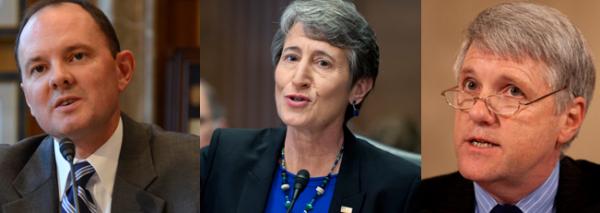
AP Images
Kevin Washburn, Sally Jewell, David Hayes.
Rob Capriccioso, Indian Country Today Media Network
When Kevin Washburn became Assistant Secretary for Indian Affairs in September 2012, he had some work to do. Not just the typical demands of running a complex subsection of a large federal agency, but also the complicated work of regaining a portfolio that had been siphoned off by overeager Obama administration officials.
Tribal officials and Indian insiders nationwide saw firsthand the shift in power away from the assistant secretary’s office in the early days of this administration, when Larry Echo Hawk, Washburn’s predecessor, was forced to recuse himself in several important Indian issues due to family ties and other possible conflicts of interest.
Concurrently, David Hayes, retiring Deputy Secretary of the department, began taking credit for progress in Indian affairs, including the Cobell settlement, water and other tribal trust settlements, while shifting any blame for problems in Indian affairs to others. Hayes, in perhaps his last leadership action on Indian affairs before exiting the department, has scheduled a June 18 teleconference on the latest aspects of the Cobell settlement land consolidation tribal trust land buyback plan. Washburn is scheduled to join him on the call.
Early on in Washburn’s tenure, Kevin Gover, who was Assistant Secretary of Indian Affairs during part of the Clinton administration, warned that Washburn was coming into a power-depleted office. “He has to confront the reality that decisions about Indian affairs are being made all over the department—not just at the BIA [Bureau of Indian Affairs],” Gover told ICTMN. “His predecessor… recused himself on a lot of key issues, including Cobell, trust, and the federal recognition cases. That means somebody else, somewhere else in the building, handled those issues. Those are major responsibilities for the assistant secretary to get back under his portfolio.”
There were some early signs that Washburn, former dean of the University of New Mexico School of Law, was working hard to take back the reins—he made several early land-into-trust decisions, announced plans to release a long overdue tribal jobs report, expressed concern that gaming has wrongly “hijacked” the federal Indian policy agenda, and promised to clean up the federal tribal recognition and trust systems.
But in the middle of this shift, his new boss, Secretary of the Department of the Interior Ken Salazar, announced he was moving on; his replacement was Sally Jewell, former CEO of an outdoor gear and clothing company, who beat out Hayes for the top spot at Interior.
That meant Washburn had a new boss to deal with, while the old guard at Interior, including Hayes, was advising Jewell on how they thought the BIA should run. Jewell has never worked in the federal government, and has little familiarity with Indian issues, which set up a potentially precarious position for Washburn.
His peril was evident on May 15, when Jewell testified before the Senate Committee on Indian Affairs for the first time to explain her Indian affairs agenda. On that day, Washburn was a thousand miles away, attending a child welfare conference in South Dakota. The same week, Jewell announced a long-awaited fracking policy affecting Indian lands with Hayes at her side; Washburn was not part of the announcement ceremony. Interior Department officials also attended and offered input an Indian affairs-focused hearing before the House Natural Resources Committee. Again, no Washburn.
Did this mean Washburn was being cut out of the loop? Jewell insists that’s not the case, telling ICTMN in a press conference call that nothing should be read into his absence, and that his attendance at the child welfare conference was a priority. “It’s difficult to get everybody in town when you want to do these,” she said, referring to the fracking announcement. “There was certainly no intent, in any way, to exclude.”
When Washburn returned to D.C., he immediately made news. Big news. He announced a so-called “Patchak Patch” to remedy a controversial and problematic Supreme Court decision tribal trust. His decision is expected to close the door on some costly lawsuits facing tribal projects on lands put into trust by the Department.
When he called ICTMN to talk Patchak, he made it very clear he was still the boss of Indian affairs—and he had a compelling argument for the recent power blips. “I was upset as anybody that I couldn’t be with the Secretary during her inaugural appearance before the Senate Committee on Indian Affairs, but I had this prior engagement that was exceedingly important and very substantive,” he said. “The Indian child welfare summit was crucial to a lot of tribes, and that’s why I was there.”
The many tribal leaders who like Washburn and want him to succeed fervently hope these recent incidents are truly attributable to scheduling conflicts or even honeymoon hiccups between Washburn and his new boss, and don’t signify a continuation of the neutered power structure that hobbled Echo Hawk. With Hayes heading out the door, there is plenty of reason to be optimistic that more strong tribal-centric fixes to federal Indian policy are yet to come under Washburn.
Read more at http://indiancountrytodaymedianetwork.com/2013/06/18/power-struggles-interior-department-impact-indian-affairs-149960
